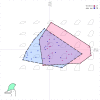Intraspecific variation and directional casque asymmetry in adult southern cassowaries (Casuarius casuarius)
- PMID: 35933695
- PMCID: PMC9482693
- DOI: 10.1111/joa.13733
Intraspecific variation and directional casque asymmetry in adult southern cassowaries (Casuarius casuarius)
Abstract
The cranial casques of modern cassowaries (Casuarius) have long intrigued researchers; however, in-depth studies regarding their morphological variation are scarce. Through visual inspection, it has been recognized that casque variability exists between conspecifics. Understanding casque variation has both evolutionary and ecological importance. Although hypothesized to be targeted by selection, intraspecific casque variation has not been quantified previously. Through a large sample of C. casuarius (n = 103), we compared casque shape (lateral and rostral views) between sexes and between individuals from non-overlapping geographical regions using two-dimensional (2D) geometric morphometrics. We found no statistically significant differences between the casque shape of females and males and few substantial shape differences between individuals from different geographic areas. Much of the intraspecific variation within C. casuarius is due to casque asymmetries (77.5% rightward deviating, 20.7% leftward deviating, and 1.8% non-deviating from the midline; n = 111), which explain the high variability of southern cassowary casque shape, particularly from the rostral aspect. Finally, we discuss how our non-significant findings implicate social selection theory, and we identify the benefits of quantifying such variation for further elucidating casque function(s) and the social biology of cassowaries.
Keywords: cranial structure; geometric morphometrics; paleognathous birds; phenotypic variation; shape analysis; social selection; theropod; visual display.
© 2022 The Authors. Journal of Anatomy published by John Wiley & Sons Ltd on behalf of Anatomical Society.
Figures










Similar articles
-
Osteological description of casque ontogeny in the southern cassowary (Casuarius casuarius) using micro-CT imaging.Anat Rec (Hoboken). 2021 Mar;304(3):461-479. doi: 10.1002/ar.24477. Epub 2020 Jul 16. Anat Rec (Hoboken). 2021. PMID: 32558300
-
Chemical immobilisation and satellite tagging of free-living southern cassowaries.Aust Vet J. 2014 Jul;92(7):240-5. doi: 10.1111/avj.12193. Aust Vet J. 2014. PMID: 24964832
-
Cassowary casques act as thermal windows.Sci Rep. 2019 Feb 13;9(1):1966. doi: 10.1038/s41598-019-38780-8. Sci Rep. 2019. PMID: 30760849 Free PMC article.
-
The phylogenetic significance of the morphology of the syrinx, hyoid and larynx, of the southern cassowary, Casuarius casuarius (Aves, Palaeognathae).BMC Evol Biol. 2019 Dec 27;19(1):233. doi: 10.1186/s12862-019-1544-7. BMC Evol Biol. 2019. PMID: 31881941 Free PMC article.
-
Does geometric morphometrics serve the needs of plasticity research?J Biosci. 2009 Oct;34(4):589-99. doi: 10.1007/s12038-009-0076-5. J Biosci. 2009. PMID: 19920343 Review.
Cited by
-
Brain shapes of large-bodied, flightless ratites (Aves: Palaeognathae) emerge through distinct developmental allometries.R Soc Open Sci. 2024 Sep 11;11(9):240765. doi: 10.1098/rsos.240765. eCollection 2024 Sep. R Soc Open Sci. 2024. PMID: 39263457 Free PMC article.
-
A taxonomic revision of the Sinopterus complex (Pterosauria, Tapejaridae) from the Early Cretaceous Jehol Biota, with the new genus Huaxiadraco.PeerJ. 2023 Feb 9;11:e14829. doi: 10.7717/peerj.14829. eCollection 2023. PeerJ. 2023. PMID: 36788812 Free PMC article.
References
-
- Andersson, M. (1994) Sexual selection. Princeton: Princeton University Press.
-
- Angst, D. , Barnoud, J. , Cornette, R. & Chinsamy, A. (2020) Sex and ontogenetic variation in the crest of Numida meleagris: implications for crested vertebrates. The Anatomical Record, 303(4), 1018–1034. - PubMed
-
- Benkman, C.W. (1996) Are the ratios of bill crossing morphs in crossbills the result of frequency‐dependent selection? Evolutionary Ecology, 10(1), 119–126.
-
- Bentrupperbaumer, J. (1997) Reciprocal ecosystem impact and behavioural interactions between cassowaries, Casuarius casuarius, and humans, Homo sapiens: exploring the natural‐human environment interface and its implications for endangered species recovery in North Queensland, Australia. PhD thesis, James Cook University.
-
- BirdLife International and Handbook of the Birds of the World . (2019). Bird species distribution maps of the world. Version 2019.1. Available at http://datazone.birdlife.org/species/requestdis.
Publication types
MeSH terms
Grants and funding
LinkOut - more resources
Full Text Sources

